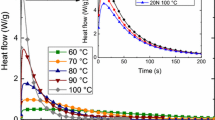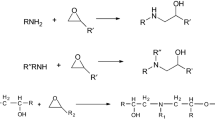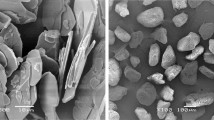Abstract
This article describes the use of thermally stimulated electrical discharge (TSD) measurements in the study of the cure processes occurring for a range of titanium dioxide, silica, and zinc oxide-pigmented epoxy polyester films. The unfilled polyester–epoxy resin system exhibits a simple TSD profile indicative of a combination of space charge and dipole relaxation processes. The addition of the Modaflow, which is used to aid in the dispersion of the pigment in the system, induces phase separation under certain cure conditions. In a number of systems, two lower temperature T g peaks were initially observed, which collapsed into a single peak on post cure. The principal difference between the two grades of titanium dioxide was the size of the space charge peak, which is a direct indication of the mobile ion content in the material. The sulfate has higher mobile ion content than the chloride route material. Differences were observed between traces of silica and zinc oxide, which reflect the ability of the particles to interact with the resin and form a dense matrix. Silica at low concentrations is able to reduce the space charge peak which implies it can trap ions. The TSD study indicates that the pigments are able to change the morphology of the matrix which is being formed.








Similar content being viewed by others
References
Liu, XD, Sudo, A, Endo, T, “Efficient Accelerating Effect of Carbonyldiimidazole on Epoxy–Dicyandiamide Curing System.” J. Polym. Sci. A Polym. Chem., 49 250–256 (2011)
Lin, R-H, “In Situ FTIR and DSC Investigation on Cure Reaction of Liquid Aromatic Dicyanate Ester with Different Types of Epoxy Resin.” J. Polym. Sci. A Polym. Chem., 38 2934–2944 (2000)
Hong, S-G, Wu, C-S, “DSC and FTIR Analyses of the Curing Behavior of Epoxy/DICY/Solvent Systems on Hermetic Specimens.” J. Therm. Anal. Calorim., 59 (3) 711–719 (2000)
Lin, YG, Sautereau, H, Pascault, JP, “BDMA-Catalyzed DDA-Epoxy Resin System—Temperature and Composition Effects on Curing Mechanism.” J. Polym. Sci. A Polym. Chem., 24 2171–2184 (1986)
Gilbert, MD, Schneider, NS, MacKnight, WJ, “Mechanism of the Dicyandiamide Epoxide Reaction.” Macromolecules, 24 360–369 (1991)
Eyerer, P, “Course of Reaction During Hardening of Epoxide Resin with Diamidimide.” J. Appl. Polym. Sci., 15 3067 (1971)
Wrasidlo, W, Levine, HH, “Polybenzimidazoles. I. Reaction Mechanism and Kinetics.” J. Polym. Sci. A, 2 (11) 4795–4801 (1964)
Hong, SG, Tsai, JS, “The Adsorption and Curing Behaviors of the Epoxy/Amidoamine System in the Presence of Metal Oxides.” J. Therm. Anal. Calorim., 63 31–46 (2001)
Hsin, L-P, Chin, W-K, “TSC Study and Electro-Optical Properties of Epoxy/Acrylic Polymer-Dispersed Liquid-Crystal Film in DICY Thermal Cure.” J. Polym. Sci. B Polym. Phys., 39 507–514 (2001)
Daly, JH, Bunton, L, Pethrick, RA, “The Effect of Cure on Thermally Stimulated Discharge Measurements in Epoxy-Resin Coatings.” J. Mater. Sci., 18 2817–2825 (1983)
Daly, JH, Bunton, L, Maxwell, ID, Pethrick, RA, “Investigation of Cure in Epoxy-Resins—Ultrasonic and Thermally Stimulated Current Measurements.” J. Appl. Polym. Sci., 24 4283–4294 (1982)
Fu, J-F, Shi, L-Y, Yuan, S, Zhong, Q-D, Zhang, D-S, Chen, Y, Wu, J, “Morphology, Toughness Mechanism, and Thermal Properties of Hyperbranched Epoxy Modified Diglycidyl Ether of Bisphenol A (DGEBA) Interpenetrating Polymer Networks.” Polym. Adv. Technol., 19 1597–1607 (2008)
Blanco, I, Cicala, G, Lo Faro, C, Motta, O, Recca, G, “Thermomechanical and Morphological Properties of Epoxy Resins Modified with Functionalized Hyperbranched Polyester.” Polym. Eng. Sci., 46 1502–1511 (2006)
Cook, WD, Chen, F, Ooi, SK, Moorhoff, C, Knott, R, “Effect of Curing Order on the Curing Kinetics and Morphology of bisGMA/DGEBA Interpenetrating Polymer Networks.” Polym. Int., 55 1027–1039 (2006)
Guo, Q, Habrard, A, Park, Y, Halley, PJ, Simon, GPJ, “Phase Separation, Porous Structure, and Cure Kinetics in Aliphatic Epoxy Resin Containing Hyperbranched Polyester.” Polym. Sci. B Polym. Phys., 44 889–899 (2006)
Mormann, W, Pokropski, T, “Curing and Morphology Studies of Thermosets from Blends of a Main Chain Liquid Crystalline Polyester and Diepoxide/Diamine.” Macromol. Mater. Eng., 290 891–898 (2005)
Cicala, G, Recca, G, “Thermomechanical and Morphological Properties of Epoxy Blends with Hyperbranched Polyester: Effect of the Pseudo-Generation Number.” J. Appl. Polym. Sci., 115 1395–1406 (2010)
Mackinnon, AJ, Jenkins, SD, McGrail, PT, Pethrick, RA, “A Dielectric, Mechanical, Rheological, and Electron-Microscopy Study of Cure and Properties of a Thermoplastic-Modified Epoxy-Resin.” Macromolecules, 25 (13) 3492–3499 (1992)
Mackinnon, AJ, Jenkins, SD, McGrail, PT, Pethrick, RA, “Dielectric, Mechanical and Rheological studies of Phase-Separation and Cure of a Thermoplastic Modified Epoxy-Resin—Incorporation of Reactively Terminated Polysulfones.” Polymer, 34 (15) 3252–3263 (1993)
Mackinnon, AJ, Jenkins, SD, McGrail, PT, Pethrick, RA, “Investigation of Thermoplastic-Modified Thermosets—Positron-Annihilation and Related Studies of an Amine-Cured Epoxy-Resin.” Polymer, 35 (24) 5319–5326 (1994)
Mackinnon, AJ, Jenkins, SD, McGrail, PT, Pethrick, RA, “Cure and Physical-Properties of Thermoplastic Modified Epoxy-Resins Based on Polyethersulfone.” J. Appl. Polym. Sci., 58 (13) 2345–2355 (1995)
Van Turnhout, J, In: Sessler, GM (ed.) ‘Electrets’—Topics in Applied Physics, Vol. 33. Springer Verlag, Berlin (1980)
Braun, JH, Baidins, A, Marganski, RE, “TiO2 Pigment Technology—A Review.” Prog. Org. Coat., 20 (2) 105–138 (1992)
Parfitt, GD, “The Role of the Surface in the Behavior of Titanium-Dioxide Pigments.” Croat. Chem. Acta, 52 333–335 (1980)
Trottier, EC, Affrossman, S, Pethrick, RA, J. Coat. Technol. Res., submitted for publication
Trottier, EC, Affrossman, S, Pethrick, RA, J. Coat. Technol. Res., in press
Grossweiner, LI, “A Note on the Analysis of 1st-Order Glow Curves.” J. Apply. Phys., 24 1306 (1953)
Acknowledgments
One of the authors (ECT) wishes to thank Tioxide and the EPSRC for maintenance during the course of this study.
Author information
Authors and Affiliations
Corresponding author
Rights and permissions
About this article
Cite this article
Trottier, E.C., Affrossman, S. & Pethrick, R.A. Cure and morphology of epoxy/polyester powder coatings containing titanium dioxide: a thermally stimulated discharge study. J Coat Technol Res 9, 717–724 (2012). https://doi.org/10.1007/s11998-012-9410-1
Published:
Issue Date:
DOI: https://doi.org/10.1007/s11998-012-9410-1




